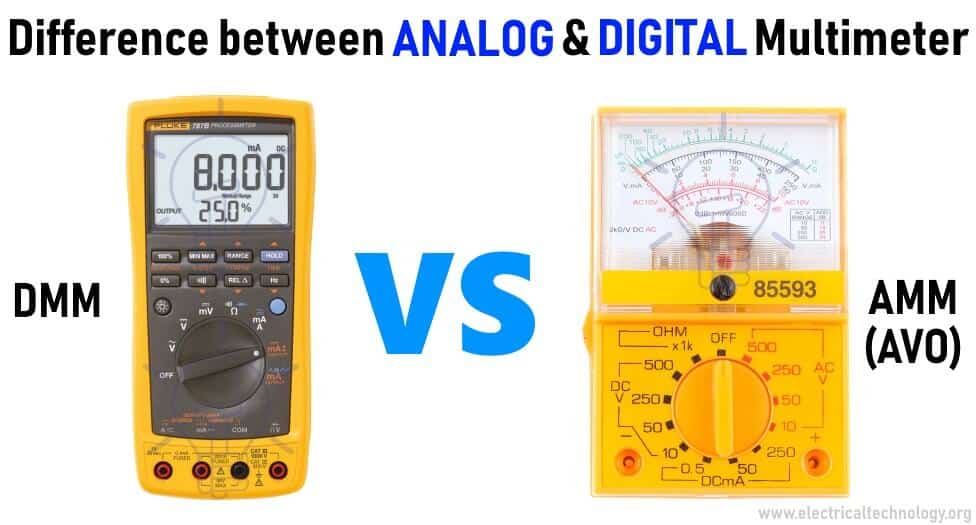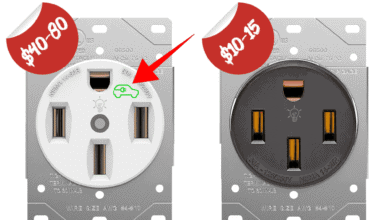Difference between Analog and Digital Multimeter
Main Differences between Digital and Analog Multimeter
Both Digital Multimeter and Analog Multimeter (also know as multi-tester) are used to test and measure different electrical quantities such as Current in Amperes, Voltage in Volts, Resistance in Ohms (Ω) etc. Digital Multimeter has some advantages as compare to Analog Multimeter as it has some additional features and ability to measure a wide range of electrical quantities. To know the basic differences between AMM and DMM, follow the article below.
- Related Post: Difference Between Capacitor and Supercapacitor
Analog Multimeter
Analog Multimeter is a simple device as compared to Digital Multimeter which is used the basic electrical quantities such as AC and DC resistance , voltage and currents etc.
Analog Multimeter (AMM) is also known as AVO Meter (Ampere, Voltage and Ohms). Inside AMM, there is a permanent magnet moving coli (Galvanometer) which is connected to the pivot of a pointer (needle as a pointer analog scale). Trimmers (as a combination of resistors) are used to measure the current in it. The deflection of the pointer indicates the measuring quantities values printed on the screen.
- Related Post: Difference Between a Battery and a Capacitor
Digital Multimeter
Digital Multimeter (DMM) is a complex combination of Analog to Digital Converter (ADC), Digital Display (LCD), Comparators, Encoders and logic controllers etc.
DMM has some advantages over AMM as it has some special features to measure additional electrical quantities. It is used to calculate electric current, voltage, resistance, capacitance, inductance, impedance etc.
One of the most feature of Digital Multimeter over Analog Multimeter is that it can be used to test and check different electronics components and devices if they are good or need to be replaced with new one.
For example, you can check a capacitor with DMM, Test different types of Transistors, test a diode, check a relay, perform a continuity test, finding the value of burnt resistors etc. It is also more accurate and easy to use as compare to AMM. That’s why Digital Multimeter is more suitable than a basic Analog Multimeter.
- Related Post: Difference Between Relay and Circuit Breaker
There are key differences between an Analog Multimeter and Digital Multimeter which are shown in the below table as comparison.
| Features | Analog Multimeter | Digital Multimeter |
| Generic Symbol |  |
 |
| Definition | An Analog Multimeter is a device used to measure limited electrical quantities such as Current, Voltage and Resistance etc. | Digital Multimeter is a device used to measure multiple electrical quantities such as Current, Voltage, Resistance, Capacitance, Diode values, Transistors etc. It can also be used to check different electronic devices such as capacitor, transistor and diodes etc. |
| Construction | Analog Multimeter is permanent magnet moving coil Galvanometer. A Galvanometer is a combination of resistors and trimmers are used to measure the current. | Digital Multimeter is a combination of complex electronics parts such as digital display as LCD, Analog to Digital Converter (ADC), Comparator, Encoder, Logic components etc. |
| Working Principle | Analog Multimeter (AMM or AVO Meter) primarily measures the current using a Galvanometer. | Digital Multimeter (DMM Meter) measures voltage using Analog to Digital Converter (ADC). |
| Functions | To Measure the Current in amperes (A), Voltage in Volts (V) and Resistance in Ohms (c). | To measure the basic electrical quantities as well as test various electronic components such as diode, transistor and capacitors etc. |
| Measuring Abilities | Normally, AVO meter measures the basic electric qualities such as current, voltage and resistance. | Mostly, DMM meter can measures basic and advance electrical quantities such as current, resistance, voltage, capacitance, inductance etc. It can be also used to check of a diode and transistor etc. are OK or faulty. |
| Reading | Analog Multimeter shows the values on a printed value scale against moving pointer. | Digital Multimeter shows reading on a digital display (LCD) in the form of numeric values. |
| Calibration | Analogue Multimeters should be calibrated manually. | Digital Multimeters provide automatic calibration. |
| Accuracy | Analog Multimeters are less accurate due to wrong pointer readings and parallax errors (viewing the pointer of an analog multimeter from another angle and misinterpret the measurement). | Digital Multimeters are most accurate as compared to analog multimeters. |
| Resolution | Superior resolution and accuracy (±5% or more). | Inferior resolution and accuracy (±3% in common). |
| Range | In Analog Multimeters, range has to be set manually for different measuring quantities by rotating the knob. | Modern Digital multimeters have the auto ranging features. |
| Ω Range | As a multiplying factor, Ohms range up to R x 10,000 ohms. | Each range is the maximum which is up to 20MΩ (mega Ohms). |
| Frequency Range | The frequency measuring rage for Analog Multimeters are up to 2kHZ. | Highest frequencies ranges can be measured by Digital Multimeter as compared to Analog multimeters. |
| Input Resistance | Input resistance of digital multimeter is constant for all the ranges to be measured. (10-22MΩ). | Input resistance is not constant in analog multimeters. i.e. it changes with range. |
| Input Signals | Analog Multimeters accept only one input signal per operation. | Digital Meters has ability to accept multiple input signals and user can chose the desired one by adjustable display. |
| Zero Ω Adjustment | No zero ohm adjustment is needed in a digital multimeter. | Zero Ohm adjustment changes with each range in Analog Multimeter. |
| Reverse Polarity | Analog Multimeter pointer attempts to deflect to the left in case of reverse polarity. | Digital Multimeter indicates a negative (-) quantity when the polarity is reversed. |
| Power Supply | Not required in case of current and voltage measurement. Power supply only required in case of resistance measurement. | Power Source is required to use the Digital Multimeter for measurement. |
| Size | Comparatively bigger. | Small as a handy tool. |
| Cost | AVO meters are less costly due to limited quantity measuring features. | DMM are costly as compared to AMM as they have more parameters measuring abilities and features. |
| Applications | Analog Multimeters are used to measure:
Measuring Resistance etc. |
Digital Multimeters are used to test and measure:
Current Voltage Resistance Inductance impedance Capacitance Capacitor Testing and even more features. |
Related Posts:
- Difference between Fuse and Circuit Breaker
- Difference between Contactor and Starter
- Difference Between MCB, MCCB, ELCB & RCB, RCD or RCCB Circuit Breakers
- Difference between Star and Delta Connections – Comparison Of Y/Δ
- Difference between Circuit Breaker and Isolator / Disconnector
- Difference between Electron Current and Conventional Current
- Difference Between DOL Starter and Soft Starter








I need more information like this.
spelling of coil is worng correct it.